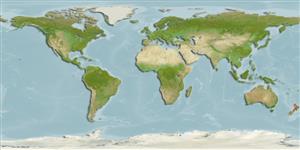>
Blenniiformes (Blennies) >
Tripterygiidae (Triplefin blennies) > Tripterygiinae
Etymology: Karalepis: Greek, kara = face + Greek, lepis = scale (Ref. 45335); stewarti: Named after A.L. Stewart of the NMNZ, Department of Fishes, collector of the holotype of this species.
Eponymy: Andrew Louis Stewart (d: 1958) is Collection Manager: Science (Fishes) at the Museum of New Zealand Te Papa Tongerewa. [...] (Ref. 128868), visit book page.
Environment: milieu / climate zone / depth range / distribution range
Ecologia
marino demersale; distribuzione batimetrica 0 - 33 m (Ref. 13227), usually 0 - 10 m (Ref. 13227). Temperate
Southwest Pacific: around mainland New Zealand.
Size / Peso / Age
Maturity: Lm ? range ? - ? cm
Max length : 15.0 cm TL maschio/sesso non determinato; (Ref. 9003)
Nocturnal species found in crevices or holes during the day. Adults feed on small crustaceans and mollusks (Ref. 13227). Eggs are hemispherical and covered with numerous sticky threads that anchor them in the algae on the nesting sites (Ref. 240). Larvae are planktonic which occur primarily in shallow, nearshore waters (Ref. 94114).
Fricke, R., 1994. Tripterygiid fishes of Australia, New Zealand and the southwest Pacific Ocean (Teleostei). Theses Zool. 24:1-585. (Ref. 13227)
IUCN Red List Status (Ref. 130435: Version 2024-1)
Threat to humans
Harmless
Human uses
Pesca: di nessun interesse
Strumenti
Special reports
Download XML
Fonti Internet
Estimates based on models
Preferred temperature (Ref.
123201): 10.6 - 21.2, mean 15.9 °C (based on 182 cells).
Phylogenetic diversity index (Ref.
82804): PD
50 = 1.0000 [Uniqueness, from 0.5 = low to 2.0 = high].
Bayesian length-weight: a=0.00692 (0.00360 - 0.01331), b=3.07 (2.90 - 3.24), in cm total length, based on LWR estimates for this species & (Sub)family-body (Ref.
93245).
Trophic level (Ref.
69278): 3.3 ±0.40 se; based on food items.
Generation time: 2.0 ( na - na) years. Estimated as median ln(3)/K based on 1
growth studies.
Resilienza (Ref.
120179): Alto, tempo minimo di raddoppiamento della popolazione meno di 15 mesi (K=0.54).
Fishing Vulnerability (Ref.
59153): Low vulnerability (10 of 100).
Nutrients (Ref.
124155): Calcium = 80.9 [49.0, 172.9] mg/100g; Iron = 0.477 [0.302, 0.830] mg/100g; Protein = 18.4 [17.5, 19.3] %; Omega3 = 0.643 [0.366, 1.176] g/100g; Selenium = 8.25 [4.20, 16.78] μg/100g; VitaminA = 22.5 [6.4, 76.3] μg/100g; Zinc = 0.813 [0.571, 1.154] mg/100g (wet weight);
